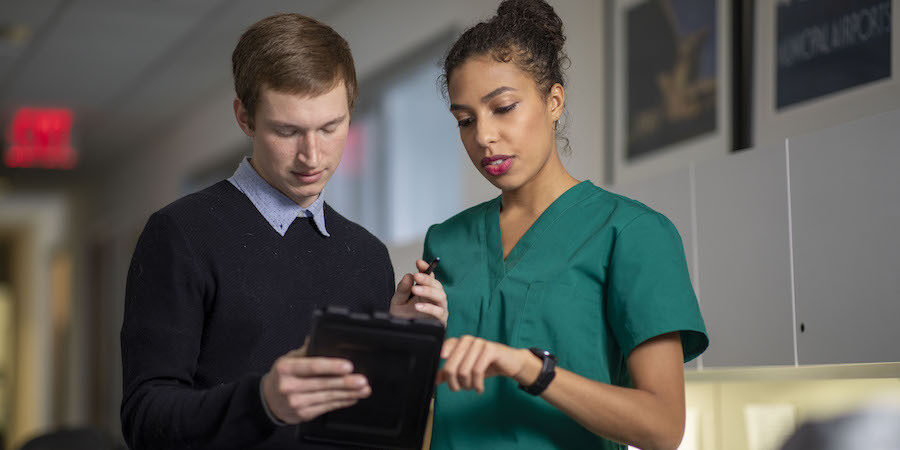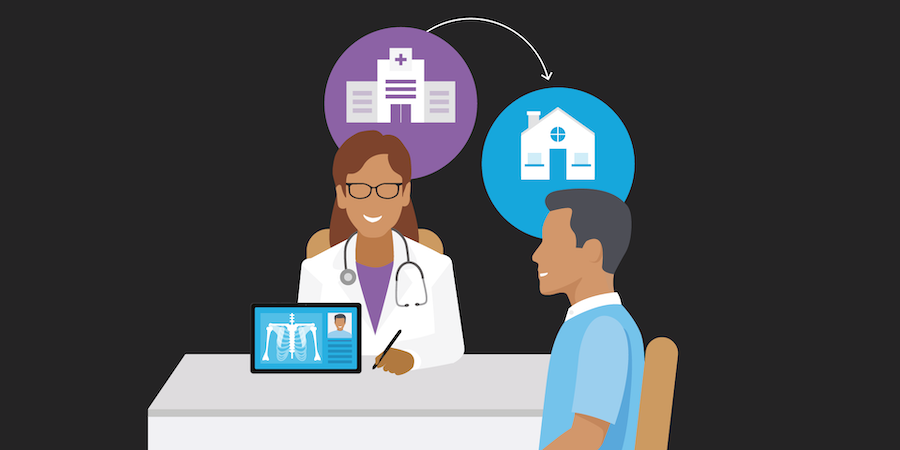With too few clinicians, too many patients and too much administrative work, care providers often lack the time to provide comprehensive patient education and personalized follow-up. That’s why patient engagement has long been a key challenge in healthcare. However, solutions are in motion — and better yet, they’re mobile.
Over the past few years, healthcare leaders have needed to quickly adapt their strategies, processes and technology to provide telehealth services. How will leading hospitals continue to use mobile technology to improve patient engagement across the care continuum — from the clinic to the hospital to the home — and deliver an increasingly connected, hybrid healthcare experience? Here are the trends we’re seeing:
1. Smart hospital rooms with bedside tablets
Smart hospital rooms put patients in control of their experience with bedside tablets that let them access information, connect with their care teams and order hospital services such as meals or fresh linens. With the right integrations, bedside tablet solutions can even put patients in control of the room itself, letting them operate lights, thermostats, televisions and blinds.
Mobile configuration providers like Oneview and Equiva offer tablet-based solutions that can power smart rooms and empower patients. Built on familiar Samsung Galaxy tablets, these solutions engage patients with highly relevant, educational content they can watch when they’re ready to learn, not just when the nurse finds time to talk. Instead of thick stacks of papers, for patients and families to read, they get on-demand videos selected by their care team. And with electronic health records (EHR) integration, they can also view their own medical records, test results and treatment schedules. Not only does this improve patient engagement and education, but it also lightens the load for nurses and enables them to spend one-on-one time with patients having meaningful conversations and answering informed questions.
Mount Sinai Hospital in New York City has equipped more than 450 patient rooms with bedside tablets. Patient rooms in newly renovated units also feature smart TVs that serve as a digital whiteboard and put the hospital one step closer to its goal of enabling truly smart patient rooms. This solution has helped the hospital improve HCAHPS scores and decrease readmissions.
2. Mobile clinical communications
The right mobile solutions can help care teams do more with less. By equipping every clinician with a smartphone and mobile clinical communications software, hospitals help them save time they would have spent tracking down colleagues. Instead of playing phone tag, they can simply call or text other care team members, and securely share photos, videos and files.
Leading clinical communication solutions can be integrated with EHR, nurse call systems and bedside telemetry machines to save nurses even more time. Instead of looking for an available computer to access patient records, or continuously hitting refresh while waiting on important lab results, nurses have patient information at their fingertips and can receive mobile notifications about urgent EHR updates. If patients need something, they can call, rather than pushing the nurse call button and requiring the nurse to trek down to the room for what might be a non-urgent request. And if an alarm goes off, the nurse gets a mobile notification, helping them to prioritize patient needs and avoid alarm fatigue.
Clinicians can use their smartphones to show patients medical diagrams, imaging results or other important visual information. In smart rooms, they can even broadcast what’s on their screen onto digital whiteboards to give patients a better view. They can also share information with patients and co-workers via interactive mobile displays like the Samsung Interactive Display, a solution that different care team members can update as they collaborate on patient care.
3. Truly hybrid care models
Now that patients and clinicians have experienced the many benefits of remote patient monitoring and telemedicine, there’s no turning back. Health systems will continue to shift more care into the home, creating hybrid models that seamlessly blend traditional in-person healthcare with virtual care — supported by digital health technology and home healthcare professionals.
Hon Pak, M.D., chief medical officer at Samsung Electronics, puts it this way: “In recent years, healthcare has begun to shift from the hospitals to ambulatory clinics, and now into the home. As this trend accelerates, it’s forcing healthcare systems to rethink what should be done in hospitals versus lower-care or outpatient settings, and what can be done in the home. The really innovative health systems are not just building new hospitals — they’re thinking about centers of excellence and then building out virtual care services [that enable a] patient-centric experience while cutting costs.”
Improve the patient experience with mobile
From check-in to remote monitoring, get your free guide to elevating care with mobile technology. Download Now
Not only is telehealth usage increasing, but so are the use cases. For instance, remote patient monitoring was once used primarily to deliver post-acute care or chronic disease management. Now healthcare providers are using it for everything from virtual physical therapy and senior care to medication adherence programs and even drug trials. Smartwatches like Samsung’s Galaxy Watch6 are being increasingly used as healthcare tools, as seen in Samsung’s HeartWise Healthcare mobile app for remote cardiac rehabilitation.
4. Continuous monitoring and data collection
As wearables and biosensors become increasingly advanced, they enable care providers to gather continuous medical and behavioral data from patients — and just as importantly, to make sense of it all. The latest and greatest remote monitoring solutions constantly analyze data and extract meaningful insights based on each individual’s personal history and trends.
Wearable remote monitoring solutions from providers like Vivify, HRS, Preventice (which put monitoring software on Samsung smartwatches) and, once again, Samsung’s own Galaxy Watch alone, can further enable hybrid care models by helping care providers gather important biometric data from afar, and around the clock. This way, both providers and patients have a complete picture of an individual’s health, not just the snapshots they get from taking vital signs during office visits. Advanced remote monitoring technology can also spot troubling trends and alert patients and their care providers and families about potential problems before there’s a medical emergency.
In short, virtual care is yet another way to improve patient engagement and enable the connected, hybrid patient experience of the future. And that future is here today.
Learn more about remote monitoring — including how it works, how it benefits healthcare providers and how to get started — with our free, comprehensive guide. Before launching your own RPM program, discover Samsung’s versatile range of virtual healthcare technologies.









